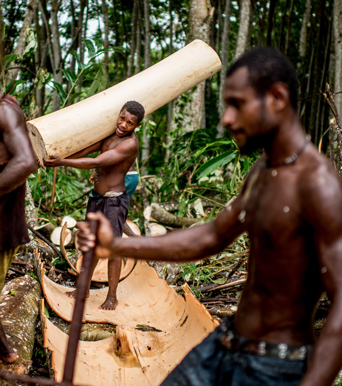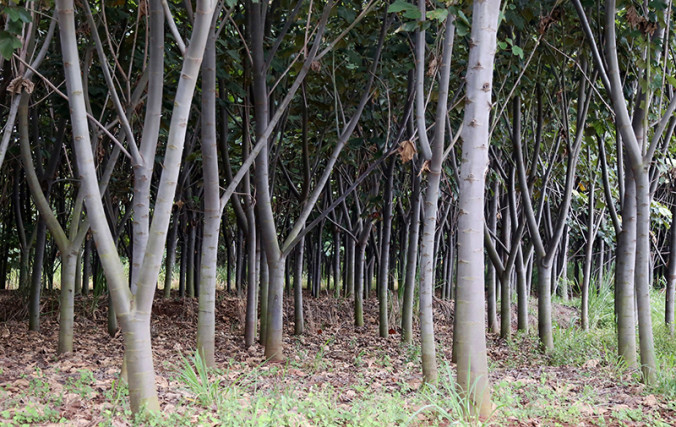The world’s lightest hardwood continues to be widely grown. Balsa (Ochroma pyramidale) is a large, fast-growing tree native from southern Mexico to southern Brazil, but can now be found in many other countries, including Papua New Guinea, Indonesia, Malaysia, Thailand, and the Solomon Islands.

Balsa log harvesting in Papua New Guinea … world’s lightest commercially-grown hardwood.
Balsa trees can establish themselves in forest clearings or on abandoned agricultural fields and grow extremely rapidly. Their speed of growth accounts for the lightness of the wood, which has a lower density than cork. Trees generally do not live beyond 30 to 40 years. Balsa is widely cultivated in the tropics where trees can grow to 25 metres with a diameter of half a metre within seven years, reaching maturity in 12-15 years.
The wood of living trees has large cells filled with water that gives the wood a spongy texture. It also makes the wood of living trees not much lighter than water and barely able to float. When the wood is kiln-dried the cells become hollow and empty. The large volume-to-surface ratio of the resulting thin-walled, empty cells gives the dried wood a high strength-to-weight ratio. The remaining cell structure is rigid, making seasoned balsa surprisingly stiff for its absurdly light weight. The density of dry balsa is typically around 160 kilograms per cubic metre.
Balsa wood exhibits an unusually high degree of buoyancy and provides very efficient insulation against heat and sound. The wood can be adapted to a great number of special end-uses. It glues well, stains and polishes satisfactorily but is very absorbent.
Balsa wood is often used as a core material in composites like the blades of wind turbines. In table tennis bats, a balsa layer is typically sandwiched between two pieces of thin plywood. Balsa is also used in laminates together with glass-reinforced plastic (fiberglass) for making high-quality balsa surfboards and for the decks and topsides of many types of boats.
Because it is low in density, but high in strength balsa is a popular material for light, stiff structures in model buildings and construction of model aircraft. However, it also is valued as a component of full-sized light aeroplanes.
It has also been indispensable to pioneers of the sea. Such light wood has often been used by raft builders, and indeed the Spanish word for a raft is balsa. From Christopher Columbus early Spanish explorers and navigators to the Americas, first encountered ‘Indians’ off-shore on rafts made from balsa.
The World War II Mosquito ‘Balsa Bomber’ was one of the world’s fastest operational aircraft. The fuselage was made from sheets of balsa glued between layers of birch.
During World War II Britain was short of aluminium but had plenty of woodworkers, and the de Havilland aircraft company turned to timber for its nimble Mosquito warplane with a speed of more than 650 kilometres per hour, the ‘Balsa Bomber’ was one of the world’s fastest operational aircraft. The fuselage was made from sheets of balsa glued between layers of birch.
